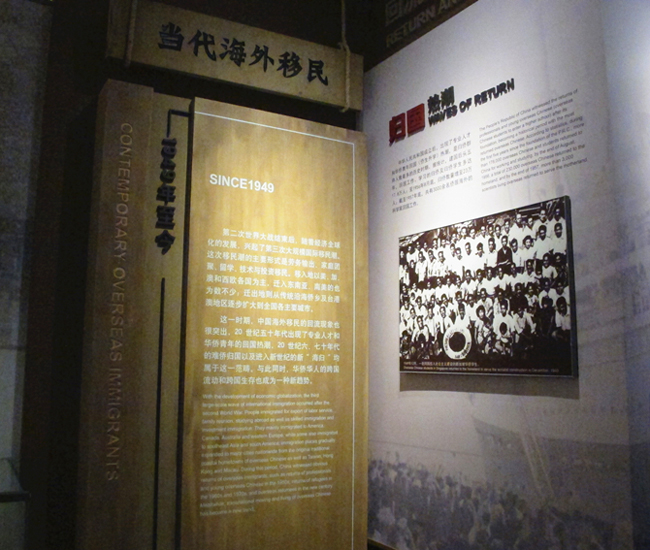 |
|
Contemporary overseas immigrants. Photo taken December 5, 2014. [Photo/CRIENGLISH.com]
|
The initiative of establishing an overseas Chinese history museum was finally realized fifty years after Tan Kah Kee, a patriotic overseas Chinese leader, first put forward the proposal in 1960. It was a gray modern building enclosed with traditional Chinese corridors, and that's how the first national museum of its kind looks like.
Located in Chaoyang District of downtown Beijing, the museum covers an area of 12,765 square meters, housing around 10,000 pieces of antique objects. Most of its collections are photos, documents and articles of daily use at different times.
The exhibition is arranged in chronological order and categorized according to different themes.
A total of four rooms respectively tell the history and lives of overseas Chinese as well as their contributions to local communities and China's modernization drive, comprehensively presenting the history, current status and future trends of overseas Chinese.
Overseas Chinese usually leave their motherland for various reasons but they never give up seeking a better life nor forget who they really are. The exhibition provides visitors with the opportunity to know these brave and tenacious people.
The history of overseas Chinese dated back to Shang Dynasty (about 1600 BC-1046 BC) and was intertwined with major events in China and the world as a whole in modern times.
As the most vivid embodiment of Chinese culture, overseas Chinese have not only spread the splendid Chinese culture to the whole world but also widened horizons of people at home, boosted cultural exchanges and enriched world civilizations.
Overseas Chinese are known for their intelligence and hardworking spirit. Most of them have to start from scratch to earn their living abroad. They have to handle collisions with local people and during their assimilation into local communities. Hard as their lives are, they have made irreplaceable contributions to the local economic, social and cultural developments.
Since the establishment of the People's Republic of China in 1949, we have witnessed a number of returned patriotic overseas Chinese who later engaged in the building of socialism. At present, overseas Chinese around the world care a lot about the development of China and are working jointly to realize the Chinese dream.
On the wall of the museum entrance hall is engraved a huge basso-relieve. It's called Roots, said a staff member. It not only symbolizes the spirit of old generations of overseas Chinese reverting to their homelands after death, but also stands for the courage and determination of young overseas Chinese to take root in foreign lands.
However, this museum still leaves much to be desired. It's facing problems such as staff shortage and lacking interactions with visitors.
With the support of governments at all levels and the generous donations from overseas Chinese, the museum is now under a trial operation. It will be officially opened to the public in spring next year.
